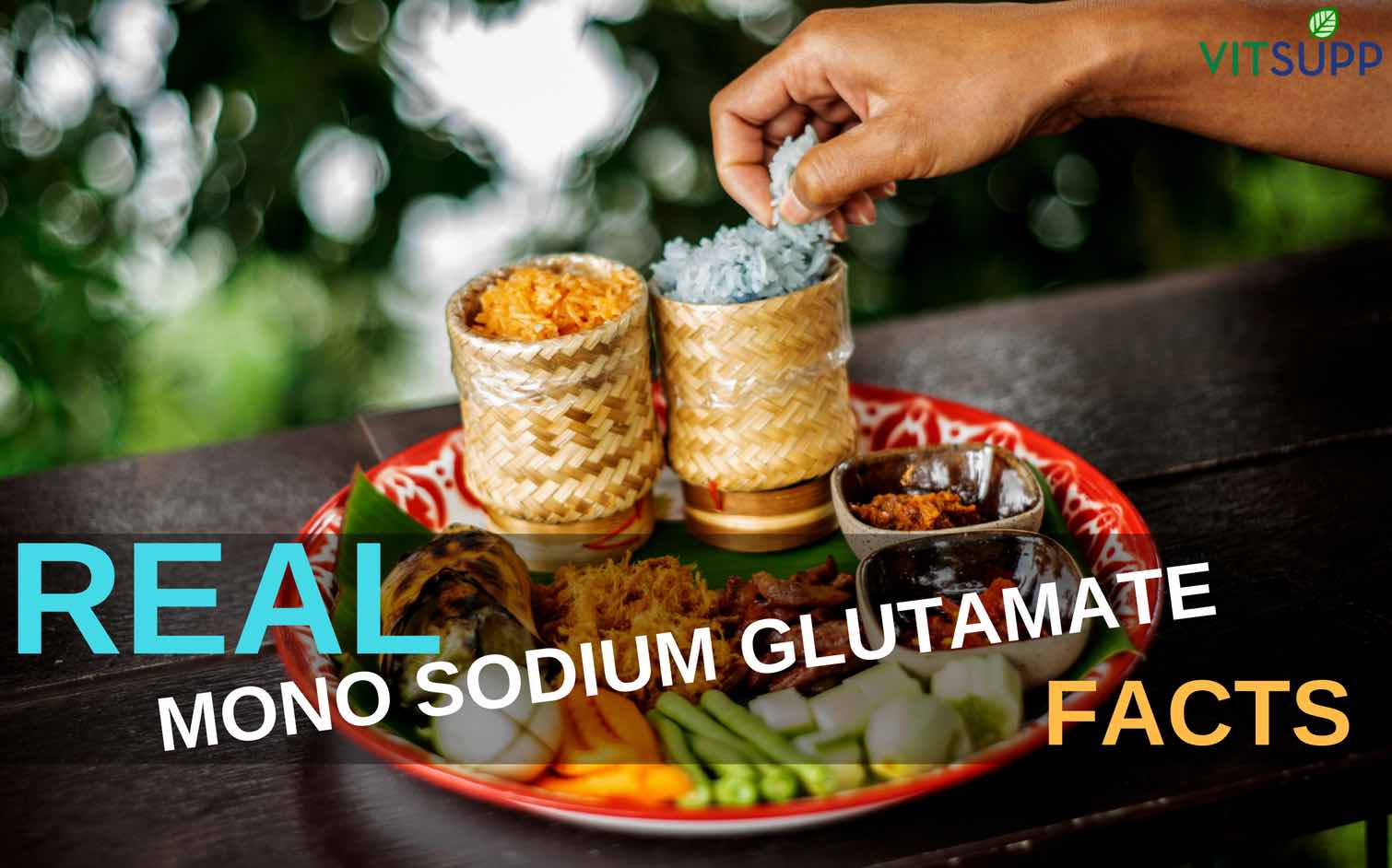Monosodium glutamate, or MSG, is a popular ingredient used by Asian restaurants to enhance savory flavors. Popularly known as Ajinomoto, it is widely believed to be a harmful compound. But is it?
Contents
- What is MSG?
- Where is MSG found?
- MSG side effects
- Is MSG bad for your health?
- MSG in food
- How to use MSG for cooking
- Safety against MSG
- Increasing usage of MSG could be detrimental to health
- Why companies write “No Added MSG”: Real MSG facts – You do not know
- Why food companies want MSG in their products: Real MSG facts – You do not know
- What is MSG
- Real MSG facts – You do not know
- MSG is a silent killer for Children: Real MSG facts – You do not know
- Real MSG facts – You do not know
- How to stop and reverse MSG damage
- Children on MSG diets may exhibit:
- Real MSG facts – You do not know
- MSG FAQs
- References
What is MSG?
MSG is the sodium salt of the abundantly occurring glutamic acid. Glutamic acid is a non-essential amino acid that gives meaty flavor to stews and broths. MSG is a flavor enhancer for savory foods, and is used widely in Chinese restaurants.
MSG was identified by German chemist Karl Heinrich Ritthausen in 1866 when he wheat gluten with sulphuric acid. In 1908, Japanese chemist Kikunae Ikeda identified MSG as flavor component. He obtained it from kombu seaweed via aqueous extraction and subsequent crystallization.
Ikeda called its taste “umami”. Ikeda called his product “monosodium glutamate”, and submitted a patent to produce MSG. In 1909, he found a way to commercially manufacture MSG from wheat and soya beans. The product was copyrighted as Aji-no-moto (essence of taste), and MSG is commonly called by that name all over the world.
Where is MSG found?
MSG is a salt of the glutamic acid, which occurs naturally in abundance in most proteins. Even human bodies contain these proteins. Some items, like tomatoes and cheese, have high amounts of MSG.
MSG side effects
MSG has been used in Asian restaurants for decades. Food and Drug Administration (FDA) classifies MSG as a food ingredient that’s “generally recognized as safe”.
MSG is rumored to be unsafe, and consuming large amounts of it is said to cause headaches. These headaches were once called the “Chinese restaurant syndrome.” However, there is no evidence to support this claim. (1)
MSG Chinese food myth
Some early studies tried to link MSG with headaches and breathing troubles. Some anecdotes were prevalent that people developed these symptoms after eating at Chinese restaurants, where MSG is widely used. No evidence was found to back the existence of this “Chinese restaurant syndrome.”
Some have attributed these rumours to anti-Asian sentiments. Critics have pointed out that this comes from a Western-centric mindset, which does not take into account the wide-spread use of MSG in Asian or Chinese cuisine.
Another prevalent myth is that MSG is linked to obesity. Tests conducted in this area have been inconclusive.(2)
Is MSG bad for your health?
Humans have been consuming foods rich in sodium and glutamate for thousands of years. No evidence exists to show it is harmful. Still, why do people regard it as harmful?
Glutamate is a neurotransmitter for brains. It is an “excitatory” neurotransmitter, that “excites” the neurons while conveying stimuli.
Experiments on mice showed that when injected with high amounts of glutamate, they showed symptoms or brain damage and also lead to death in some. In females, it increased sterility and in some adult mice, there were signs of stunted growth.(3)
The results of this study might be the basis of fears about MSG. However, there is no evidence that shows that such drastic change in glutmate can happen from eating foods containing MSG. Several experiments showed eating food with MSG had no effect on humans.
MSG production process
For large-scale commercial uses, MSG is is obtained from natural materials like corn starch, sugar cane, molasses and sugar beets. The fermentation process used to make MSG introduces micro-organisms to syrups, letting the former to produce proteins that are necessary for themselves.
Many enzymes are used subsequently, which makes these micro-organisms produce a number of amino acids. This method has been popular since the 1960s. Earlier, the extraction method was used for commercial production. (4)
MSG in food
Pure MSG does not have a pleasant taste. However, it enhances the “meaty” flavor when used in food.
Since MSG occurs naturally in tomatoes, peas and cheese; products like tomato puree, ketchup, pea puree, and processed cheese have a high amount of MSG. It is also used widely in soy sauce, savory snacks and meals, stocks, soups and Chinese seasonings. (5)
In any case, it should be remembered that MSG is a naturally occurring ingredient that is there in almost every protein and savory-tasting foods. If you avoid Chinese or Asian restaurants, chances are you are consuming it anyway in store-bought or even home-made stocks, soups, cheese, peas and tomatoes.
How to use MSG for cooking
MSG can be used as an additive to bring out the umami flavors. MSG can enhance the flavor of meat soups, broths, stews and stocks.
Sprinkling just a bit of MSG on a any meat dish enhances its flavor. Adding a pinch of MSG to your noodles will make it extra tasty. Add it in gravies and see the difference. Use it for sauces that go with meat. If you want to make Asian one-pot meals or food bowls, pinch in some MSG while boiling the soup or gravy.
Since MSG goes well with salty and savory flavors, it can be used to cook seafood. It can also be added to make eggs tastier. MSG can also bring out the flavors of vegetables like broccoli, mushrooms, spinach or kale. However, it does nothing for sweet or bitter flavors. So don’t use MSG while making desserts, chocolates, candy or bitter vegetables.
Like any other food seasoning- do not overdo it. Raw MSG has an unpleasant taste, and if you add too much to your food, it will overwhelm your taste-buds.
At the end of the day, remember that like any garnish or condiment, MSG cannot compensate for bad cooking. Experiment with it to strike the perfect balance for your recipes.
Is there MSG in Indian food?
According to the Food Safety and Standards Authority of India (FSSAI), MSG can be added to specific food items, and should be mentioned on the packaging. The FSSAI states that since MSG is a naturally occurring substance in most proteins, it is almost impossible to determine whether it was added artificially during the production or not.
While MSG is known to be used widely in Chinese or Asian restaurants, it may be used in continental or other cuisines to highlight flavors of meat.
However, MSG is not used in any traditional Indian cuisine.
Safety against MSG
Over the years, some anecdotes have tries to assert that MSG has adverse side effects. However, in these stories, symptoms mentions are mild and do not pose any health risky. If you are unsure about the effects of MSG, you can try avoiding foods containing MSG. So, avoid eating and ordering from Chinese or Asian restaurants.
Check condiments, sauces and other compounds used in Asian food. FDA requires MSG to be listed in the ingredients in any food with it. Avoid using those products.
Many food item manufacturers produce MSG-free products for their customers. Check for such brands or products if you want to avoid MSG altogether.
MSG can be found in highly seasoned or flavored foods. These are usually Chinese or Asian take away items that have soy sauce. However, MSG as an additive is used mostly for commercial purposes and not in home-cooked meals.
Food from restaurants otherwise contain a number of processed substances which are unhealthy and fatty. These can lead to obesity and related complication.
Better to avoid processed or junk food. While MSG contained in Chinese or Asian take away items is not harmful, other preservatives and condiments used in them may affect your health.
Increasing usage of MSG could be detrimental to health
Have you noticed a label “No Added MSG” on your packet of chips and other food products. Like me you must have wondered
- Why it is written in such a funny manner. Why can’t they simply write No MSG.
- If it is not there then why are they writing it specifically. The product might be missing many such ingredients and companies should be illustrating the ingredients of their food products only.
Why companies write “No Added MSG”: Real MSG facts – You do not know
Companies write “No added MSG” when MSG is actually present there, however the manufacturer is not adding it from outside. This funny way of writing is evolved because MSG is not safe for humans and is pretty unsafe for children. One can argue that it is safe for consumption however the truth is that it is unsafe and there is a tacit admission of the fact. However nobody will openly admit it as such an admission will ensure that consumer will never buy such products.
Large number of consumers are aware of the detrimental effects of MSG. Therefore by saying “No Added MSG” food companies are actually fooling consumers and implying that MSG is not there.
Why food companies want MSG in their products: Real MSG facts – You do not know
The real food ingredients are getting more and more expansive and food companies want to meet that specific price point of Rs 10-20-30 etc so that consumer particularly kids buy such products on impulse. At the same time they tickle our taste buds so that there is some kind of addiction stay with their products. To sum it they want to offer cheap yet tasty products to consumer. This is where MSG comes into picture.
MSG is a dirt cheap salt, popularly know as “chinese salt” in India and it can enhance the taste of anything and everything. So with MSG food companies can cheap products that taste really good and consumer keep coming and buying.
What is MSG
MSG or Monosodium Glutamate (also known as sodium glutamate) is the sodium salt of glutamic acid. Glutamic acid is one of the most abundant naturally occurring non-essential amino acids and it is found in tomatoes, Parmesan cheese, potatoes, mushrooms, and other vegetables and fruits.
MSG is used in the food industry as a flavor enhancer with an umami taste that intensifies the meaty, savory flavor of food, as naturally occurring glutamate does in foods such as stews and meat soups. MSG as a flavor enhancer balances, blends, and rounds the perception of other tastes. It is particularly popular in Korean, Japanese, and Chinese cuisine.
Real MSG facts – You do not know
In 1957 two ophthalmology residents, Lucas and Newhouse, tested monosodium glutamate(MSG) on infant (suckling) and adult mice. On examining the tissues of these animals, post-mortem, it was found that virtually all of the nerve cells in the inner layer of the animal’s retinas had been destroyed. The worst damage occurred in the newborn mice, but even the adults showed significant injury.
Unfortunately this important finding went virtually unnoticed by the medical world, and especially by the food industry, which at the time was adding tons of MSG to all commercially prepared foods. It is added to baby food even now.
Mothers, unaware of the danger to their children, are delighted to see their little ones eating so well. Because MSG and hydrolyzed protein are such powerful taste enhancers, they make most foods, even the bland ones, taste scrumptious.
How to stop and reverse MSG damage
The antioxidant vitamin E has been shown to significantly block the toxic effect of glutamate in brain cell cultures.
Almost all junk foods and fast foods contain massive amounts of MSG and other excitoxin taste enhancers,
Children on MSG diets may exhibit:
- Obesity
- Hyperactivity
- Behavioral Disorders (due to hypothylamic injury)
- Learning Disorders (due to hypothylamic injury)
- Delayed speech OR stuttering (due to brain damage)
Always enquire after the ingredients of your store bought food. Better yet stick to homemade.
MSG FAQs
What is MSG?
Monosodium glutamate or MSG is the sodium salt of glutamic acid. Glumatic acid is occurs abundantly in nature, and is a non-essential amino acid found in almost all plant and animal proteins.
Is MSG natural?
Yes. Glutamic acid is a widely occurring amino acid that is present in almost all animal and plant proteins. Even the human body contains MSG. It also acts as a neurotransmitter in our nervous systems.
Which foods contain MSG?
All proteins have MSG. However, it can be found in higher concentrations in tomatoes, peas, cheese and soya beans. MSG is responsible for the savory or umami taste we associate with meat, tomatoes and soya beans.
Where is MSG used?
MSG is widely used by restaurants to flavor savory food. It is very popular in Chinese and Pan-Asian restaurants. It is also found in Pan-Asian condiments like soya sauce. MSG is also common is dressings and garnishes for meat items, and found in meat broths, stews and stocks.
Is there MSG in Indian foods?
In home-cooked meals, there is no MSG. Many reports, however, suggest that MSG is used in many restaurants, even that which do not serve Chinese or Asian foods. If you are adding any seasonings, garnishes or sauces, check the packaging to see if it lists MSG. Many product manufacturers specifically mention “MSG free” in their packaging.
Can I use MSG for cooking?
Yes. You can use it to enhance flavors of savory dishes like meat and seafood meals. You can use it to make soups, Asian bowls, noodles and gravy. If you are cooking Chinese dishes at home using required condiments and sauces, chances are they already contain MSG, so taste before adding extra amounts to your food.
How much MSG should I use?
Just a pinch. Too much can overwhelm the taste. MSG has an unpleasant taste in itself.
What are the side effects of MSG?
None have been identified by scientific studies, but some people report having headaches. If you are unsure about consuming it, do not indulge in it. Always remember that MSG is an additive in most restaurant foods, particularly in those that serve Asian cuisine. Restaurant takeaways and food is high on preservatives and trans fats which are not good for the body and may lead to obesity. If you want to stay healthy, avoid eating out too much for long term health benefits.
Is MSG safe?
Yes. No scientific evidence exists that proves consuming food with MSG is harmful for humans. MSG is an “excitable” neurotransmitter, i.e., it excites the neurons while transmitting stimuli to the brain. Studies show that when mice were injected with more MSG, their growth stunted and they showed symptoms of brain damage. While there is no scientific evidence that eating foods seasoned with MSG increases MSG levels in the body to toxic amounts, it is best to avoid foods you are not comfortable eating.
References
- Does monosodium glutamate really cause headache? : a systematic review of human studies. NCBI
- Monosodium glutamate is not associated with obesity or a greater prevalence of weight gain over 5 years: findings from the Jiangsu Nutrition Study of Chinese adults NCBI
- Brain lesions, obesity, and other disturbances in mice treated with monosodium glutamate NCBI
- History of glutamate production American Journal of Clinical Nutrition
- Monosodium Glutamate (MSG) Nestle


